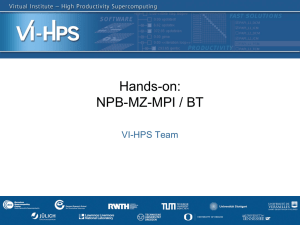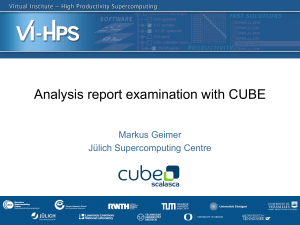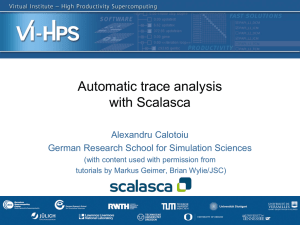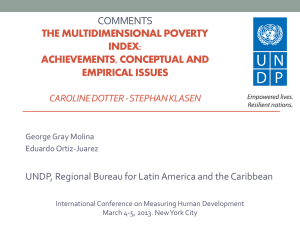Scalasca
advertisement
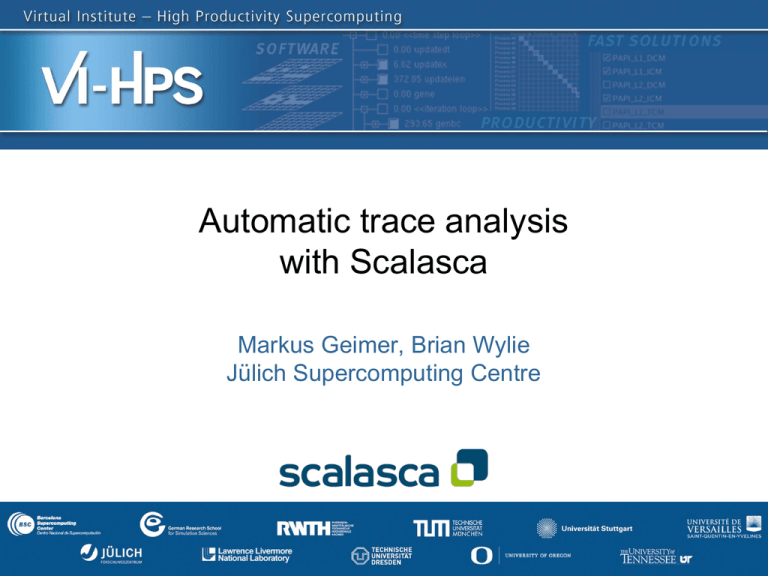
Automatic trace analysis
with Scalasca
Markus Geimer, Brian Wylie
Jülich Supercomputing Centre
DKRZ Tutorial 2013, Hamburg
Automatic trace analysis
• Idea
Low-level
event trace
Analysis
High-level
result
Property
– Automatic search for patterns of inefficient behaviour
– Classification of behaviour & quantification of significance
Call
path
Location
– Guaranteed to cover the entire event trace
– Quicker than manual/visual trace analysis
– Parallel replay analysis exploits available memory & processors
to deliver scalability
DKRZ Tutorial 2013, Hamburg
2
The Scalasca project: Overview
• Project started in 2006
– Initial funding by Helmholtz Initiative & Networking Fund
– Many follow-up projects
• Follow-up to pioneering KOJAK project (started 1998)
– Automatic pattern-based trace analysis
• Now joint development of
– Jülich Supercomputing Centre
– German Research School for Simulation Sciences
DKRZ Tutorial 2013, Hamburg
3
The Scalasca project: Objective
• Development of a scalable performance analysis toolset
for most popular parallel programming paradigms
• Specifically targeting large-scale parallel applications
– such as those running on IBM BlueGene or Cray XT systems
with one million or more processes/threads
• Latest release in March 2013: Scalasca v1.4.3
• Here: (almost final) Scalasca v2.0 with Score-P support
– Will be officially released in the next days
DKRZ Tutorial 2013, Hamburg
4
Scalasca 1.4 features
• Open source, New BSD license
• Portable
– IBM BlueGene, IBM SP & blade clusters, Cray XT, SGI Altix,
Fujitsu FX10 & K computer, NEC SX, Intel Xeon Phi, Solaris &
Linux clusters, ...
• Supports parallel programming paradigms & languages
– MPI, OpenMP & hybrid MPI+OpenMP
– Fortran, C, C++
• Integrated instrumentation, measurement & analysis
toolset
– Runtime summarization (callpath profiling)
– Automatic event trace analysis
DKRZ Tutorial 2013, Hamburg
5
Scalasca 2.0 features
• Open source, New BSD license
• Uses Score-P instrumenter & measurement libraries
– Scalasca 2.0 core package focuses on trace-based analyses
– Generally same usage as Scalasca 1.4
• Supports common data formats
– Reads event traces in OTF2 format
– Writes analysis reports in CUBE4 format
• Still aims to be portable
– But not widely tested yet
– Limitation:
• Unable to handle OTF2 traces containing CUDA events
DKRZ Tutorial 2013, Hamburg
6
Measurement
library
HWC
Instr.
target
application
Optimized measurement configuration
Local event
traces
Parallel waitstate search
Summary
report
Wait-state
report
Report
manipulation
Scalasca workflow
Scalasca trace analysis
Instrumented
executable
Which problem?
Where in the
program?
Which
process?
Instrumenter
compiler /
linker
Source
modules
DKRZ Tutorial 2013, Hamburg
7
Example: Wait at NxN
MPI_Allreduce
location
MPI_Allreduce
MPI_Allreduce
MPI_Allreduce
time
• Time spent waiting in front of synchronizing collective
operation until the last process reaches the operation
• Applies to: MPI_Allgather, MPI_Allgatherv, MPI_Alltoall,
MPI_Reduce_scatter, MPI_Reduce_scatter_block,
MPI_Allreduce
DKRZ Tutorial 2013, Hamburg
8
Example: Late Broadcast
MPI_Bcast
location
MPI_Bcast (root)
MPI_Bcast
MPI_Bcast
time
• Waiting times if the destination processes of a collective
1-to-N operation enter the operation earlier than the source
process (root)
• Applies to: MPI_Bcast, MPI_Scatter, MPI_Scatterv
DKRZ Tutorial 2013, Hamburg
Example: Late Sender
MPI_Send
location
MPI_Recv
location
MPI_Isend
location
MPI_Recv
MPI_Send
MPI_Irecv
MPI_Send
MPI_Wait
time
MPI_Recv
MPI_Wait
MPI_Isend
MPI_Irecv
MPI_Wait
time
MPI_Wait
time
• Waiting time caused by a blocking receive operation posted
earlier than the corresponding send
• Applies to blocking as well as non-blocking communication
DKRZ Tutorial 2013, Hamburg
Hands-on:
NPB-MZ-MPI / BT
DKRZ Tutorial 2013, Hamburg
Scalasca compatibility command: skin
• Scalasca application instrumenter
% skin
Scalasca 2.0: application instrumenter using scorep
usage: skin [-v] [–comp] [-pdt] [-pomp] [-user] <compile-or-link-cmd>
-comp={all|none|...}: routines to be instrumented by compiler
(... custom instrumentation specification for compiler)
-pdt: process source files with PDT instrumenter
-pomp: process source files for POMP directives
-user: enable EPIK user instrumentation API macros in source code
-v:
enable verbose commentary when instrumenting
--*:
options to pass to Score-P instrumenter
– Provides compatibility with Scalasca 1.X
– Generally use Score-P instrumenter directly
DKRZ Tutorial 2013, Hamburg
12
Scalasca convenience command: scan
• Scalasca measurement collection & analysis nexus
% scan
Scalasca 2.0: measurement collection & analysis nexus
usage: scan {options} [launchcmd [launchargs]] target [targetargs]
where {options} may include:
-h
Help: show this brief usage message and exit.
-v
Verbose: increase verbosity.
-n
Preview: show command(s) to be launched but don't execute.
-q
Quiescent: execution with neither summarization nor tracing.
-s
Summary: enable runtime summarization. [Default]
-t
Tracing: enable trace collection and analysis.
-a
Analyze: skip measurement to (re-)analyze an existing trace.
-e exptdir
: Experiment archive to generate and/or analyze.
(overrides default experiment archive title)
-f filtfile : File specifying measurement filter.
-l lockfile : File that blocks start of measurement.
DKRZ Tutorial 2013, Hamburg
13
Scalasca convenience command: square
• Scalasca analysis report explorer
% square
Scalasca 2.0: analysis report explorer
usage: square [-v] [-s] [-f filtfile] [-F] <experiment archive
| cube file>
-F
: Force remapping of already existing reports
-f filtfile : Use specified filter file when doing scoring
-s
: Skip display and output textual score report
-v
: Enable verbose mode
DKRZ Tutorial 2013, Hamburg
14
Automatic measurement configuration
• scan configures Score-P measurement by setting some
environment variables automatically
– e.g., experiment title, profiling/tracing mode, filter file, …
– Precedence order:
• Command-line arguments
• Environment variables already set
• Automatically determined values
• Also, scan includes consistency checks and prevents
corrupting existing experiment directories
• For tracing experiments, after trace collection completes
then automatic parallel trace analysis is initiated
– uses identical launch configuration to that used for measurement
(i.e., the same allocated compute resources)
DKRZ Tutorial 2013, Hamburg
15
BT-MZ summary measurement
• Change to the directory containing the executable before
running it and adjust configuration
% cd bin.scorep
% cp ../jobscript/blizzard/* .
% vim scalasca2.ll
...
# Runtime summarization w/ filtering
scan –f ../config/scorep.filt poe ./bt-mz_B.4
...
DKRZ Tutorial 2013, Hamburg
BT-MZ summary measurement
• Run the application using the Scalasca measurement
collection & analysis nexus prefixed to launch command
% llsubmit scalasca2.ll
% cat nas_bt_mz.job.o<id>
S=C=A=N: Scalasca 2.0 runtime summarization
S=C=A=N: ./scorep_bt-mz_B_4x4_sum experiment archive
S=C=A=N: Thu Sep 13 18:05:17 2012: Collect start
poe ./bt-mz_B.4
NAS Parallel Benchmarks (NPB3.3-MZ-MPI) - BT-MZ MPI+OpenMP Benchmark
Number of zones:
8 x
8
Iterations: 200
dt:
0.000300
Number of active processes:
4
[... More application output ...]
S=C=A=N: Thu Sep 13 18:05:39 2012: Collect done (status=0) 22s
S=C=A=N: ./scorep_bt-mz_B_4x4_sum complete.
• Creates experiment directory ./scorep_bt-mz_B_4x4_sum
DKRZ Tutorial 2013, Hamburg
17
BT-MZ summary analysis report examination
• Score summary analysis report
% square -s scorep_bt-mz_B_4x4_sum
INFO: Post-processing runtime summarization result...
INFO: Score report written to ./scorep_bt-mz_B_4x4_sum/scorep.score
• Post-processing and interactive exploration with CUBE
% square scorep_bt-mz_B_4x4_sum
INFO: Displaying ./scorep_bt-mz_B_4x4_sum/summary.cubex...
[GUI showing summary analysis report]
• The post-processing derives additional metrics and
generates a structured metric hierarchy
DKRZ Tutorial 2013, Hamburg
18
Post-processed summary analysis report
Split base metrics into
more specific metrics
DKRZ Tutorial 2013, Hamburg
19
BT-MZ trace measurement collection...
• To enable additional statistics and pattern instance
tracking, set SCAN_ANALYZE_OPTS=“-i -s” (2.0b only)
% export SCAN_ANALYZE_OPTS=“-i -s”
• Re-run the application using Scalasca nexus with “-t” flag
% scan –f scorep.filt -t poe ./bt-mz_B.4
S=C=A=N: Scalasca 2.0 trace collection and analysis
S=C=A=N: ./scorep_bt-mz_B_4x4_trace experiment archive
S=C=A=N: Thu Sep 13 18:05:39 2012: Collect start
poe ./bt-mz_B.4
NAS Parallel Benchmarks (NPB3.3-MZ-MPI) - BT-MZ MPI+OpenMP Benchmark
Number of zones:
8 x
8
Iterations: 200
dt:
0.000300
Number of active processes:
4
[... More application output ...]
S=C=A=N: Thu Sep 13 18:05:58 2012: Collect done (status=0) 19s
[.. continued ...]
DKRZ Tutorial 2013, Hamburg
20
BT-MZ trace measurement ... analysis
• Continues with automatic (parallel) analysis of trace files
S=C=A=N: Thu Sep 13 18:05:58 2012: Analyze start
poe scout.hyb –i -s ./scorep_bt-mz_B_4x4_trace/traces.otf2
SCOUT
Copyright (c) 1998-2012 Forschungszentrum Juelich GmbH
Copyright (c) 2009-2012 German Research School for Simulation
Sciences GmbH
Analyzing experiment archive ./scorep_bt-mz_B_4x4_trace/traces.otf2
Opening experiment archive
Reading definition data
Reading event trace data
Preprocessing
Analyzing trace data
Writing analysis report
Max. memory usage
...
...
...
...
...
...
done
done
done
done
done
done
(0.002s).
(0.004s).
(0.669s).
(0.975s).
(0.675s).
(0.112s).
: 145.078MB
Total processing time
: 2.785s
S=C=A=N: Thu Sep 13 18:06:02 2012: Analyze done (status=0) 4s
DKRZ Tutorial 2013, Hamburg
21
BT-MZ trace analysis report exploration
• Produces trace analysis report in experiment directory
containing trace-based wait-state metrics
% square scorep_bt-mz_B_4x4_trace
INFO: Post-processing runtime summarization result...
INFO: Post-processing trace analysis report...
INFO: Displaying ./scorep_bt-mz_B_4x4_sum/trace.cubex...
[GUI showing trace analysis report]
DKRZ Tutorial 2013, Hamburg
22
Post-processed trace analysis report
Additional trace-based
metrics in metric hierarchy
DKRZ Tutorial 2013, Hamburg
23
Online metric description
Access online metric
description via context
menu
DKRZ Tutorial 2013, Hamburg
24
Online metric description
DKRZ Tutorial 2013, Hamburg
25
Pattern instance statistics
Click to get
statistics details
Access pattern instance
statistics via context menu
DKRZ Tutorial 2013, Hamburg
26
Connect to Vampir trace browser
To investigate most severe
pattern instances, connect
to a trace browser…
DKRZ Tutorial 2013, Hamburg
…and select trace file from
the experiment directory
27
Show most severe pattern instances
Select “Max severity in trace
browser” from context menu
of call paths marked with a
red frame
DKRZ Tutorial 2013, Hamburg
28
Investigate most severe instance in Vampir
Vampir will automatically
zoom to the worst
instance in multiple steps
(i.e., undo zoom provides
more context)
DKRZ Tutorial 2013, Hamburg
29
Further information
Scalable performance analysis of
large-scale parallel applications
– toolset for scalable performance measurement & analysis of
MPI, OpenMP & hybrid parallel applications
– supporting most popular HPC computer systems
– available under New BSD open-source license
– sources, documentation & publications:
• http://www.scalasca.org
• mailto: scalasca@fz-juelich.de
DKRZ Tutorial 2013, Hamburg
30
